Bathroom Flooring Options
Researching flooring for the bathroom? You’re in the right place. Your best bet for a durable, low-maintenance floor is a range of 100% waterproof bathroom flooring options such as waterproof core vinyl or porcelain and ceramic tile. Water-resistant laminate is also a great option.
Waterproof bathroom floors are quick and easy to clean. They also come in a huge variety of styles, from wood look to stone look and beyond, so there’s sure to be an option to match your preference.
With so many flooring options to choose from, the task of finding the right floor for you can be a challenge. The good news is I’ve done the work for you! I’ve compiled a list of waterproof bathroom flooring ideas with pros and cons, and figured out what flooring might work best for your specific bathroom.
Waterproof bathroom floors are quick and easy to clean. They also come in a huge variety of styles, from wood look to stone look and beyond, so there’s sure to be an option to match your preference.
With so many flooring options to choose from, the task of finding the right floor for you can be a challenge. The good news is I’ve done the work for you! I’ve compiled a list of waterproof bathroom flooring ideas with pros and cons, and figured out what flooring might work best for your specific bathroom.
Best Waterproof Bathroom Flooring Options
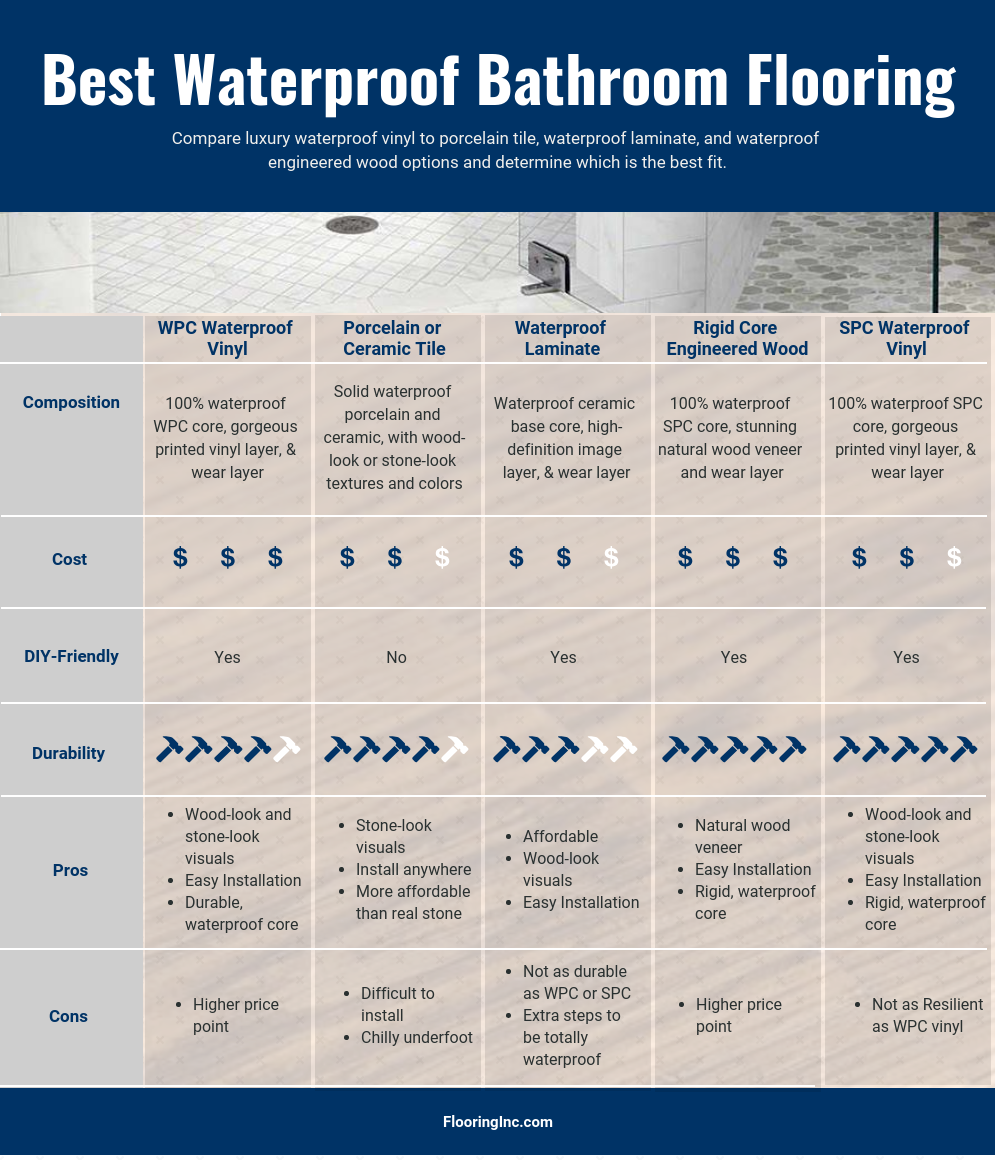
100% Waterproof Vinyl Floors
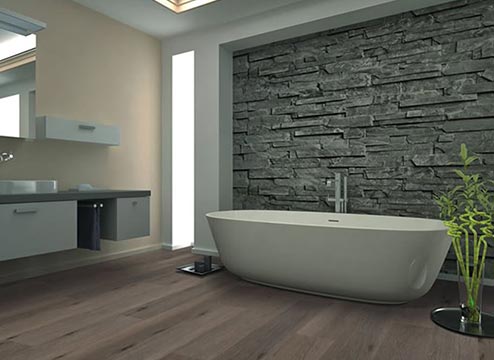
Waterproof vinyl floors come in two styles: wood plastic composite (WPC), and stone plastic composite (SPC). WPC vinyl is made from a mixture of plastic and wood flour. SPC vinyl is similarly composed of plastic and – you guessed it – stone!
WPC and SPC are high-end flooring options that have taken the interior design world by storm.
Even ten years ago, you might have read the word “vinyl” and thought “cheap,” or “flimsy,” but those days are over. Now, boasting a 100% waterproof guarantee, WPC and SPC engineered vinyl planks are luxury flooring solutions fit for any home.
WPC and SPC are high-end flooring options that have taken the interior design world by storm.
Even ten years ago, you might have read the word “vinyl” and thought “cheap,” or “flimsy,” but those days are over. Now, boasting a 100% waterproof guarantee, WPC and SPC engineered vinyl planks are luxury flooring solutions fit for any home.
What the Experts Say About Waterproof Vinyl
“When it comes to Mannington’s Adura Products, you can only begin to imagine. Not only do we have the most stunning visuals but when exposed to water, our vinyl will not lose its structural integrity. Install any of our Adura products in a bathroom and be confident to let life happen.” – Sean Laizure | Mannington Mills
“[Engineered] vinyl floors are a great option to give you that wood look in the bathroom where you would never install real wood. They are easy to install, warmer to walk on than tile and 100% waterproof. They can even be installed over radiant floors.” – Bryan Schwieger | US Floors
“[Engineered] vinyl floors are a great option to give you that wood look in the bathroom where you would never install real wood. They are easy to install, warmer to walk on than tile and 100% waterproof. They can even be installed over radiant floors.” – Bryan Schwieger | US Floors
What makes WPC and SPC Vinyl Flooring Waterproof?
The answer is in the innovative layered design. Usually, WPC and SPC vinyl flooring is made up of four layers, but this can vary between manufacturers. Let’s look at the typical build for a piece of quality waterproof vinyl flooring.
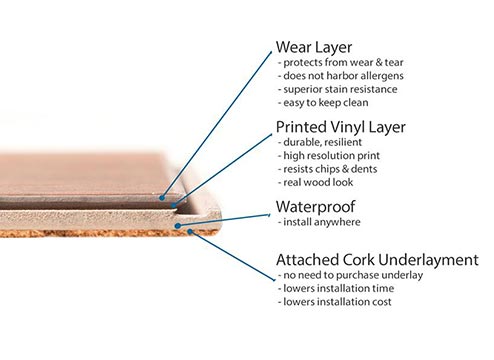
Wear Layer
This is the powerhouse of your waterproof vinyl floor. The wear layer is the surface you walk on, and this is the first defense for your flooring. Waterproof vinyl floors are known for their thick, substantial wear layers. The thicker this layer is, the more durable your floor.Printed Vinyl Layer
Here comes the fun part. High-quality vinyl is some of the best material on the market for mimicking natural textures. Wood-look, stone-look, you name it. WPC and SPC vinyl flooring offers realistic visuals that could convince anyone it’s the genuine material.Waterproof Core
WPC vinyl is sometimes also called waterproof core vinyl, and that’s thanks to this crucial layer. The waterproof center will not absorb liquid, no matter how long it’s put to the test. No mildew, no warping, no swelling. No problem!
SPC vinyl also boasts a totally waterproof core. In stone plastic composite flooring, this layer is thinner and a lot more dense, and that increases the durability. This rigid, durable design makes SPC floors perfect for commercial use.
This backing is often an attached layer of cork or foam, and it eliminates your need to buy a separate underlayment. This layer also adds some spring to the floor, and muffles the hollow sounds in the room.
Backing Layer
The backing layer meets your subfloor, smoothing out any imperfections in the surface without costing you a lot of money in repairs.This backing is often an attached layer of cork or foam, and it eliminates your need to buy a separate underlayment. This layer also adds some spring to the floor, and muffles the hollow sounds in the room.
Unbeatable Waterproof Bathroom Flooring
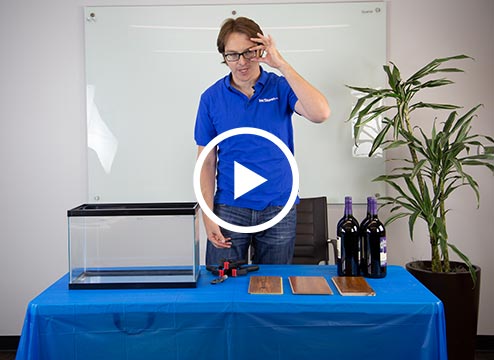
All together, these four layers make WPC and SPC vinyl flooring completely waterproof. It’s true! But you don’t have to take our word for it. We put our waterproof core vinyl to the test with the Red Wine Challenge.
What’s the Red Wine Challenge, you ask?
Well, we soaked our waterproof vinyl flooring in red wine for an entire day. Then we compared it to other popular flooring solutions, like engineered hardwood and laminate, to see which floor could stand up to the test.
What’s the Red Wine Challenge, you ask?
Well, we soaked our waterproof vinyl flooring in red wine for an entire day. Then we compared it to other popular flooring solutions, like engineered hardwood and laminate, to see which floor could stand up to the test.
Types of Waterproof Vinyl Flooring
Waterproof vinyl flooring is available in two main types, and it’s important to know the difference between the two when considering a bathroom flooring update.
Waterproof Vinyl Plank Flooring
Vinyl plank flooring comes in long planks that resemble traditional wood flooring. If you’re looking for an artificial wood floor, this is your ideal choice.
Waterproof Vinyl Tile Flooring
Tiles are your other main style of vinyl flooring. Designed to mimic stone tiles, these square waterproof vinyl tiles are offered in a variety of textures.
Waterproof Vinyl Pros
- WPC and SPC Vinyl is Completely Waterproof: This 100% waterproof flooring won’t soak up moisture and cause you big problems in the long run.
- It’s Ultra Durable: The top wear layer acts as a buffer against scuffs, scratches, and stains.
- Printed Vinyl Layer Keeps Up with the Times: Whether you want a classic wood pattern or a trendy stone look, these waterproof core vinyl floors have something to offer.
- WPC and SPC Flooring is Easy to Clean: A quick sweep and a few passes of the mop can restore your bathroom floor to its awesome self.
- You Can Do it Yourself: All you need to install waterproof vinyl is some time and a set of directions from the manufacturer. You can even snap it together over existing flooring.
- SPC is Affordable: SPC vinyl can cost about the same as tile flooring, and since installation is simpler, you won’t need to hire an installer.
Waterproof Vinyl Cons
- WPC Can be More Expensive: WPC vinyl flooring scores high on all flooring metrics, from durability to comfort, so of course you’ll need to pay a little more for it.
Porcelain and Ceramic Tile Floors

Tile has been a leader in bathroom flooring for years, and this dependable flooring solution has a lot to offer! With tile flooring, you can expect durability and versatility. By versatility, I mean this flooring offers a variety of colors and shapes.
You could opt for a more natural wood or stone texture, or you could go all out on a turquoise tile cut into hexagons. Tile is all about customization, and you have the opportunity to express your inner interior designer when updating your bathroom floor (or walls!) with tile.
You could opt for a more natural wood or stone texture, or you could go all out on a turquoise tile cut into hexagons. Tile is all about customization, and you have the opportunity to express your inner interior designer when updating your bathroom floor (or walls!) with tile.
Construction of Tile Flooring

Body
This is the material of your tile. Both porcelain and ceramic tiles are made from a mixture of water and clay minerals. Porcelain is composed of dense minerals like feldspar, kaolin, and quartz. Ceramic clay is less dense and contains less kaolin.Due to compositional differences between porcelain and ceramic tiles, the body colors differ. The body of a traditional ceramic tile is typically red. Porcelain tiles have a through-color that matches the glaze of the tile.
Pattern and Color
This is the fun layer! Once shaped and dried, porcelain and ceramic tiles are printed with patterns and colors using a commercial inkjet printer. The tile glaze is also applied during this step.Glaze
The glaze layer is what you see on the surface of the tile. The glaze protects the image and seals the tile from moisture. Porcelain tiles don’t require a glaze, but ceramic tiles should definitely be glazed if you want to use them for a waterproof surface.
If porcelain tile is chipped, you’ll find that the glaze color is the same as the body of the tile. However, chipped ceramic tile will show the red body underneath the glaze.
Ceramic tiles go through the same process at a slightly cooler 2000F, so it’s less durable, but still super waterproof.
Firing
Hot, hot, hot! The firing process sets the glaze and bakes away the excess moisture in your tiles. Porcelain tiles are fired at 2500F in order to melt some of the clay minerals into glass, and that’s what makes this flooring so waterproof and durable.Ceramic tiles go through the same process at a slightly cooler 2000F, so it’s less durable, but still super waterproof.
Types of Tile Flooring

Porcelain and Ceramic Planks
Just like waterproof vinyl, porcelain and ceramic flooring can mimic wood and stone textures. When you’re shopping for wood-look porcelain flooring, it will typically come in these plank shapes for a more realistic design.Porcelain and Ceramic Tiles
Tiles are a more common shape for porcelain and ceramic flooring. Tiles are great for stone-look floors, and the larger size of floor tiles can make even the smallest space feel roomy.Ultra-Thin Gauged Floor Tiles
We singled out this bathroom tile in our piece on tile trends. Ultra-thin tile tends to come in large slabs or panels, so this flooring is a bit tricky to install. However, since it’s so light, thin gauged flooring is cheaper to ship, making it a cost-effective solution.Tile Flooring Pros
- It’s Both Trendy and Time Honored: Bathroom tile flooring can mimic natural textures, or be cut into adventurous shapes, and whatever you choose will last for years.
- Bathroom Tile Floors Are Durable: Perfect for high-traffic areas like the bathroom, tile floors won’t wear down, peel up, or scuff.
- Cleaning Tile is a Breeze: It’s easy to clean your new tile flooring with just a broom and mop.
Tile Flooring Cons
- It’s Tough: Tile floors can be rough on your joints if you’re standing for an extended time, and it’s not forgiving if you have a less than perfect subfloor.
- Burrr, It’s Chilly: Cold tile bathroom floors aren’t very welcoming, but there are some solutions for this issue (which I will get to later).
- Hard to Install: It’s best for DIYers to sit this one out and hire a professional to cut and lay their tile.
Natural Stone Tile Floors

The naturally occurring patterns in stone floors are popular for a reason: they’re beautiful! With a huge variety of colors and textures to choose from, there is certain to be a genuine stone floor for your luxury interior design needs. Stone flooring is a good option to consider if you have the money.
Natural Stone Flooring Pros
- Pure Luxury: If you have the budget for natural stone floors, then splurging on stone tiles in your bathroom will add a touch of luxury in your everyday routine.
- It Looks Great: Natural stone is obviously beautiful. Whether you choose marble, travertine, granite, or something else entirely, you can enjoy a stylish stone bathroom floor that will be the envy of your guests.
Natural Stone Flooring Cons
- Expensive: There’s no getting around it. Natural stone floors are pricey. If you want the same stylish looks without the hefty price tag, consider stone-look vinyl or porcelain tiles.
- Hard to Maintain: Stone floors require regular sealing and resurfacing to ensure the lifelong quality of your investment. Stone-look vinyl or porcelain tiles offer the same durability without all the fuss.
- Difficult to DIY: Unless you regularly cut and lay stone tiles in your free time, stone floor installation is best left to the pros.
Water-Resistant Laminate Floors

Synthetic laminate flooring has been around since the 1970’s, but it hasn’t been the best performer in rooms with lots of potential for moisture.
Until now!
Water-resistant laminate flooring is making it possible to install laminate in your bathroom, as long as you take the appropriate steps.
Until now!
Water-resistant laminate flooring is making it possible to install laminate in your bathroom, as long as you take the appropriate steps.
What You Need to Know About Water-Resistant Laminate Floors in Bathrooms
When buying laminate floors for your bathroom, you need to thoroughly read over the product descriptions to make sure your choice is truly water-resistant.
For your bathroom, you’ll want to purchase laminate with a medium-density fiberboard (MDF) core, because this core contains water resistant materials like wax. Water-resistant laminate with an MDF core can avoid soaking up standing water for a short time before it finally absorbs.
For your bathroom, you’ll want to purchase laminate with a medium-density fiberboard (MDF) core, because this core contains water resistant materials like wax. Water-resistant laminate with an MDF core can avoid soaking up standing water for a short time before it finally absorbs.
How to Make Sure Your Laminate Flooring is Actually Water-Resistant
During your search for the best bathroom flooring, be sure to confirm the core material of your laminate before buying. You want to be sure to get laminate with a quality, high-density core.
During installation, apply glue or caulk around the edges of the planks. This will seal up any cracks where water could leak.
To add even more protection against water damage, you should add an underlayment and vapor barrier beneath your laminate. By gluing down your laminate flooring over these barriers, you are protecting it against subfloor moisture.
During installation, apply glue or caulk around the edges of the planks. This will seal up any cracks where water could leak.
To add even more protection against water damage, you should add an underlayment and vapor barrier beneath your laminate. By gluing down your laminate flooring over these barriers, you are protecting it against subfloor moisture.
Construction of Water-Resistant Laminate Flooring

Wear Layer
Just like with waterproof vinyl, the wear layer is the first defense against everyday wear and tear. The thicker the wear layer, the beefier your flooring.Photographic Image
The pattern of your flooring resides in the image layer, kept safe by the wear layer. This high-resolution image can be of a pattern, or often the wood and stone looks that are trendy right now.Water-Resistant Core
All the durability of your laminate flooring comes from the core layer. This core is what makes your laminate water-resistant, too. Water-resistant laminate will have a medium-density fiberboard core with wax or other water-repellent materials to ensure no water soaks through.Backing/Stabilizing Layer
The backing of laminate flooring stabilizes the whole plank and gives you a good foundation for your floor. Unlike waterproof vinyl, the backing layer for water-resistant laminate typically doesn’t come with an attached underlayment, though some options do offer a pre-attached underlay. For a more resilient and water-resistant floor, purchase a quality underlayment and vapor barrier.Laminate Flooring Pros
- DIY-Friendly: Water-resistant laminate is easy to install by yourself using the simple, interlocking design that DIYers of all levels can tackle.
- Mimics Stone and Tile: In addition to the detailed printed layer, water-resistant laminate floors can feature an embossed texture to make it feel like the real thing.
Laminate Flooring Cons
- Not Completely Waterproof: Water-resistant laminate is great for dealing with moisture at the top of the floor, but it’s not waterproof from the bottom. Any water coming up from the subfloor can still cause issues.
More Waterproof Bathroom Flooring Options
Waterproof Carpet Floors
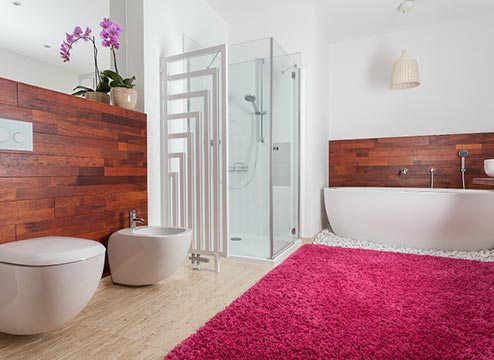
Okay, maybe you just did a double take after reading the words “waterproof” and “carpet” together like that, but trust us, it’s the real thing.
Waterproof carpet is made with RX2 technology, which repels liquid like magic. Except it’s not magic; it’s science! Every fiber of waterproof carpeting is coated in RX2 to ensure a soil-proof, stain-proof, and waterproof product.
Moisture that reaches the carpet base has to contend with the 100% waterproof Lifeguard backing. No water can penetrate this water repellant base. In fact, all moisture is wicked back to the surface of the rug for you to blot away with ease.
Convinced yet? Waterproof bathroom carpet is a great solution for avoiding slippery flooring. Additionally, if you want to warm up your bathroom with a touch of softness, you might consider waterproof carpet.
Waterproof carpet is made with RX2 technology, which repels liquid like magic. Except it’s not magic; it’s science! Every fiber of waterproof carpeting is coated in RX2 to ensure a soil-proof, stain-proof, and waterproof product.
Moisture that reaches the carpet base has to contend with the 100% waterproof Lifeguard backing. No water can penetrate this water repellant base. In fact, all moisture is wicked back to the surface of the rug for you to blot away with ease.
Convinced yet? Waterproof bathroom carpet is a great solution for avoiding slippery flooring. Additionally, if you want to warm up your bathroom with a touch of softness, you might consider waterproof carpet.
Flooring Not Recommended for the Bathroom
Some flooring was made to thrive in your bathroom, and other options are better off in other parts of the house. Here’s what you definitely shouldn’t consider when updating bathroom flooring.
- Hardwood Flooring: Wood flooring is not completely waterproof, so if you have standing water, you need to clean it up quickly. It requires a lot of upkeep. We’re talking specialized wood flooring cleaners, adding finishing coats, and even sanding and refinishing.
- Non-Waterproof Carpet: Regular carpet absorbs water and messes, so you’ll always be walking on a soggy surface. Gross! It requires frequent washing. If you want to avoid mold or mildew, you should wash your carpet at least once a week.
- Linoleum: Linoleum scratches easily, and those tiny tears trap dust and dirt, making it hard to clean. Linoleum also absorbs water, which leads to a lot of headaches. In humid environments (like bathrooms), linoleum curls up at the edges, creating an unsightly appearance.
Best Bathroom Floors for Every Use
No two bathrooms are the same, so why pretend there is a one-size-fits-all flooring solution for bathrooms? With so many great bathroom flooring ideas, you can be sure to find the right flooring to fit your needs.
Best Flooring for High Traffic Bathrooms
Sometimes it can feel like the main bathroom is busier than Grand Central Station, with kids washing off messes, pets getting a bath, and everything in between. For the multi-purpose bathroom in everyone’s life, the best bathroom floor options are durable and low-maintenance.
- Large, Smooth Bathroom Tiles: Cleaning doesn’t get much easier than with large tile flooring. The smooth surface of the tiles can’t collect any grime, and the larger tile size eliminates a lot of grout lines requiring extra attention.
- SPC Waterproof Vinyl Floors: For flooring that stands up to high-traffic use, consider rigid waterproof core vinyl with a thick wear layer. SPC vinyl flooring is designed for use in commercial spaces, meaning it can definitely hold up even in the busiest bathroom.
- Porcelain Tile Bathroom Flooring: Porcelain is definitely the best tile option for a high traffic bathroom. This dense, durable tile doesn’t chip easily, but if you somehow manage to crack a corner, porcelain’s through-body color will make it virtually impossible to spot.
Best Bathroom Flooring for Kids

Let’s face it: life is messy. And with children in the house, it’s a good idea to plan ahead for those messes. Defend against inevitable splashes and spills with more durable bathroom flooring options.
- Waterproof Carpeting: Children’s bathrooms might frequently have standing water, and that creates a slippery floor. To avoid slips and accidents, add a layer of traction and padding with a waterproof rug. Waterproof bathroom carpets also warm up the space.
- Waterproof Core Vinyl Floor: WPC and SPC vinyl is so dependable that it can work anywhere, even in your child’s bathroom. This heavy duty flooring will perform for years and years, even after your little ones are out of the house.
- Durable Bathroom Tile Flooring: If you want a flooring solution that’s hassle free and durable, porcelain and ceramic tile is for you. Tile floors are dense enough to withstand heavy traffic without wearing down. You’re going to love that durability when lots of little feet are parading through the bathroom in the mornings.
Bathroom Flooring Ideas for Guest Bathrooms
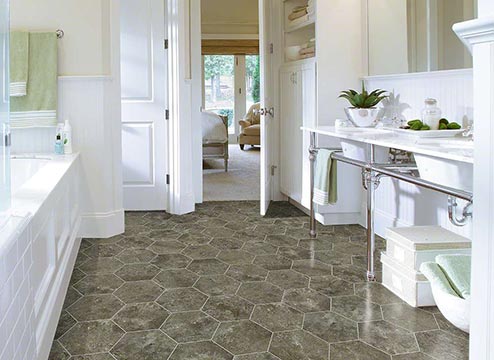
Maybe your guest bathroom doesn’t get a lot of use, but that’s no excuse to let it languish with outdated flooring. Use this space as an opportunity to show your personality with trendy bathroom floor colors and styles.
- Non-Traditional Shaped Floor Tiles: Use unique tile flooring shapes to make a big statement. From floral patterns to bold chevron stripes, tile flooring offers a majorly customizable selection. With tile, you can create stunning mosaics to wow your visitors.
- Colorful Bathroom Flooring: This year’s trends are in full swing, and the tastemakers say the next big thing in bathroom floors is color. A bright accent color in your flooring tiles can light up the room and bring in a renewed energy to your space.
Master Bathroom Flooring Ideas
At the end of a long day, nothing can compare to stepping out of a hot shower and onto your luxury bathroom flooring. For a master bathroom like no other, choose high quality flooring that delivers style and functionality.
- Marble-Look Tile: Bring that sought-after marble aesthetic to your home without the price tag of real marble. Smooth tile floors can be printed with the classic marble look to transform your master bathroom into a spa-like retreat.
- Textured WPC and SPC Vinyl Floors: This one is a no-brainer. Waterproof vinyl offers the best of every flooring option in one luxury package. Let us count the ways: WPC and SPC vinyl is 100% waterproof, super durable, low-maintenance, and stylish. What more could you want?
Bathroom Flooring FAQs
What is the Best Type of Flooring for a Bathroom?

Waterproof flooring like vinyl or tile offers the best of bathroom flooring. In addition to being waterproof, these options are durable, low-maintenance, stylish, and cheaper than real stone or wood.
Waterproof vinyl and tile each win the title of best bathroom flooring. But it really depends on what you need. I suggest making a list of your main bathroom flooring concerns, and then working back from there.
Large families with pets will want a heavy-duty, easy to maintain bathroom floor solution like WPC or SPC vinyl. Meanwhile a less hectic home might be better suited to handle a bathroom floor with lots of intricate tiles or a more slippery surface.
Waterproof vinyl and tile each win the title of best bathroom flooring. But it really depends on what you need. I suggest making a list of your main bathroom flooring concerns, and then working back from there.
Large families with pets will want a heavy-duty, easy to maintain bathroom floor solution like WPC or SPC vinyl. Meanwhile a less hectic home might be better suited to handle a bathroom floor with lots of intricate tiles or a more slippery surface.
Is Vinyl Plank Flooring Good in a Bathroom?
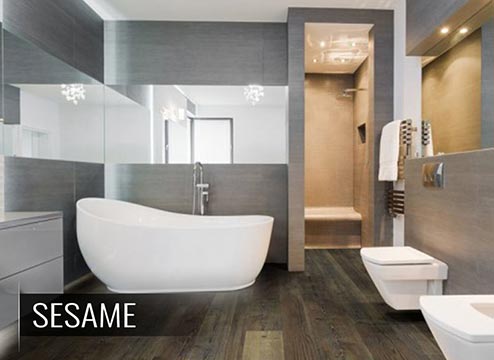
Engineered vinyl planks and tiles are a great choice for the bathroom. Vinyl planks with a waterproof core such as WPC or SPC vinyl are designed specifically to prevent water damage while making your bathroom look beautiful.
You can enjoy trendy wood-look and stone-look styles without having to maintain the real material. Waterproof vinyl also offers warmth and resilience with every step.
You can enjoy trendy wood-look and stone-look styles without having to maintain the real material. Waterproof vinyl also offers warmth and resilience with every step.
Is it OK to Put Laminate Flooring in a Bathroom?
You can install water-resistant laminate in your bathroom as long as you take the right steps to ensure it’s totally water-resistant. Start by purchasing laminate flooring with a medium-density fiberboard core.
Follow all manufacturer instructions during installation and be sure to seal any places where water could leak through. You should also invest in a quality underlayment and vapor barrier to prevent issues with subfloor moisture.
Follow all manufacturer instructions during installation and be sure to seal any places where water could leak through. You should also invest in a quality underlayment and vapor barrier to prevent issues with subfloor moisture.
How Do I Clean My Bathroom Floor?
For waterproof bathroom floors like porcelain tiles and vinyl planks, clean-up is as simple as a quick run of the vacuum and some swipes of a damp mop. This is great for people like me who don’t want to invest a lot of time and money into special cleaning products for the bathroom.
What Bathroom Flooring is Easiest to Maintain?
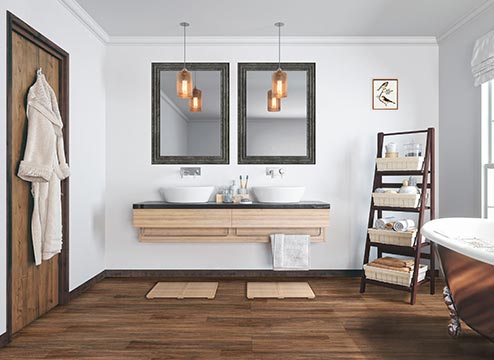
Waterproof vinyl and rigid core engineered wood floors are some of the easiest, low-maintenance flooring options you can find. With thick wear layers to protect against high traffic, and ultra-strong, waterproof cores, these floors can stand up to just about anything.
In the case of SPC vinyl planks, they’re actually designed for commercial use in places like grocery stores and hospitals. It doesn’t matter how busy your bathroom is – you’re not going to put a dent in this flooring.
In the case of SPC vinyl planks, they’re actually designed for commercial use in places like grocery stores and hospitals. It doesn’t matter how busy your bathroom is – you’re not going to put a dent in this flooring.
Conclusion
If you’re looking for new bathroom flooring ideas that are high quality and low maintenance, then look no further than our wide selection of waterproof flooring. With vinyl and tile options in almost every style, you can keep up with the trending looks without sacrificing durability.
Best of all, you can rest easy knowing that you have a completely waterproof bathroom floor.
Ready to try some out?
Best of all, you can rest easy knowing that you have a completely waterproof bathroom floor.
Ready to try some out?

